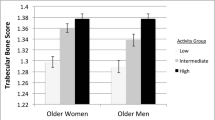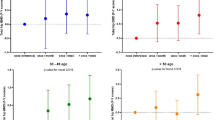Abstract
Although the positive association between physical activity and bone mineral density (BMD) is well established, few epidemiological studies have investigated the long-term associations between physical activity during adulthood and BMD later in life. The aim of this prospective, population-based study was to examine the association between leisure time physical activity in adulthood and areal BMD (aBMD) later in life. We examined 1,766 women and 1,451 men aged 20–54 years at baseline who were followed up 22 years later, as part of a population-based study in Norway. Leisure time physical activity was assessed by questionnaire at baseline and follow-up. aBMD was measured at the hip and forearm at follow-up, using X-ray absorptiometry. The association between aBMD and physical activity was analyzed using general linear models. We observed a positive linear trend in aBMD across physical activity levels in both women and men, after adjustments for baseline age, height, weight, and smoking status (P < 0.05). The relationship between aBMD and leisure time physical activity was consistent over different sites of the hip (total hip, femoral neck and trochanter area) and forearm (distal and ultradistal area). In a subsample of 2,436 men and women under 70 years of age, those who where sedentary at both baseline and follow-up (6%) had lower aBMD than those who were moderately active or active at both baseline and follow-up (71%) (P ≤ 0.01). This study suggests that leisure time physical activity in adulthood is associated with higher aBMD and reduced risk of osteoporosis later in life.

Similar content being viewed by others
Abbreviations
- aBMD:
-
Areal bone mineral density
- CI:
-
Confidence interval
- DXA:
-
Dual-energy X-ray absorptiometry
- MET:
-
Metabolic equivalent
- OR:
-
Odds ratio
- QCT:
-
Quantitative computed tomography
- SD:
-
Standard deviation
- SXA:
-
Single X-ray absorptiometry
References
Cole ZA, Dennison EM, Cooper C. Osteoporosis epidemiology update. Curr Rheumatol Rep. 2008;10:92–6.
Cummings SR, Melton LJ. Epidemiology and outcomes of osteoporotic fractures. Lancet. 2002;359:1761–7.
Karlsson MK, Nordqvist A, Karlsson C. Sustainability of exercise-induced increases in bone density and skeletal structure. Food Nutr Res. 2008; 52. doi:10.3402/fnr.v52i0.1872. Epub 2008 Oct 1.
Barry DW, Kohrt WM. Exercise and the preservation of bone health. J Cardiopulm Rehabil Prev. 2008;28:153–62.
Beck BR, Snow CM. Bone health across the lifespan—exercising our options. Exerc Sport Sci Rev. 2003;31:117–22.
Kohrt WM, Bloomfield SA, Little KD, Nelson ME, Yingling VR, American College of Sports M. American College of Sports Medicine Position Stand: physical activity and bone health. Med Sci Sports Exerc. 2004;36:1985–96.
WHO Scientific Group on the Prevention, Management of Osteoporosis. Prevention and management of osteoporosis: report of a WHO Scientific Group. Geneva: World Health Organization; 2003.
Delvaux K, Lefevre J, Philippaerts R, Dequeker J, Thomis M, Vanreusel B, et al. Bone mass and lifetime physical activity in Flemish males: a 27-year follow-up study. Med Sci Sports Exerc. 2001;33:1868–75.
Van Langendonck L, Lefevre J, Claessens AL, Thomis M, Philippaerts R, Delvaux K, et al. Influence of participation in high-impact sports during adolescence and adulthood on bone mineral density in middle-aged men: a 27-year follow-up study. Am J Epidemiol. 2003;158:525–33.
Barnekow-Bergkvist M, Hedberg G, Pettersson U, Lorentzon R. Relationships between physical activity and physical capacity in adolescent females and bone mass in adulthood. Scand J Med Sci Sports. 2006;16:447–55.
Foley S, Quinn S, Dwyer T, Venn A, Jones G. Measures of childhood fitness and body mass index are associated with bone mass in adulthood: a 20-year prospective study. J Bone Miner Res. 2008;23:994–1001.
Duppe H, Gardsell P, Johnell O, Ornstein E. Bone mineral density in female junior, senior and former football players. Osteoporos Int. 1996;6:437–41.
Etherington J, Harris PA, Nandra D, Hart DJ, Wolman RL, Doyle DV, et al. The effect of weight-bearing exercise on bone mineral density: a study of female ex-elite athletes and the general population. J Bone Miner Res. 1996;11:1333–8.
Greendale GA, Barrett-Connor E, Edelstein S, Ingles S, Haile R. Lifetime leisure exercise and osteoporosis. The Rancho Bernardo study. Am J Epidemiol. 1995;141:951–9.
Ilich-Ernst J, Brownbill RA, Ludemann MA, Fu R. Critical factors for bone health in women across the age span: how important is muscle mass? Medscape Women’s Health. 2002;7:2.
Karlsson MK, Hasserius R, Obrant KJ. Bone mineral density in athletes during and after career: a comparison between loaded and unloaded skeletal regions. Calcif Tissue Int. 1996;59:245–8.
Karlsson MK, Johnell O, Obrant KJ. Is bone mineral density advantage maintained long-term in previous weight lifters? Calcif Tissue Int. 1995;57:325–8.
Karlsson MK, Linden C, Karlsson C, Johnell O, Obrant K, Seeman E. Exercise during growth and bone mineral density and fractures in old age. Lancet. 2000;355:469–70.
Kolbe-Alexander TL, Charlton KE, Lambert EV. Lifetime physical activity and determinants of estimated bone mineral density using calcaneal ultrasound in older South African adults. J Nutr Health Aging. 2004;8:521–30.
Kriska AM, Sandler RB, Cauley JA, LaPorte RE, Hom DL, Pambianco G. The assessment of historical physical activity and its relation to adult bone parameters. Am J Epidemiol. 1988;127:1053–63.
Lynch NA, Ryan AS, Evans J, Katzel LI, Goldberg AP. Older elite football players have reduced cardiac and osteoporosis risk factors. Med Sci Sports Exerc. 2007;39:1124–30.
Nilsson M, Ohlsson C, Eriksson AL, Frandin K, Karlsson M, Ljunggren O, et al. Competitive physical activity early in life is associated with bone mineral density in elderly Swedish men. Osteoporos Int. 2008;19:1557–66.
Rideout CA, McKay HA, Barr SI. Self-reported lifetime physical activity and areal bone mineral density in healthy postmenopausal women: the importance of teenage activity. Calcif Tissue Int. 2006;79:214–22.
Uzunca K, Birtane M, Durmus-Altun G, Ustun F. High bone mineral density in loaded skeletal regions of former professional football (soccer) players: what is the effect of time after active career? Br J Sports Med. 2005;39:154–7.
Wilsgaard T, Arnesen E. Body mass index and coronary heart disease risk score: the Tromsø study, 1979 to 2001. Ann Epidemiol. 2007;17:100–5.
Graff-Iversen S, Anderssen SA, Holme IM, Jenum AK, Raastad T. Two short questionnaires on leisure-time physical activity compared with serum lipids, anthropometric measurements and aerobic power in a suburban population from Oslo, Norway. Eur J Epidemiol. 2008;23:167–74.
Løchen ML, Rasmussen K. The Tromsø study: physical fitness, self reported physical activity, and their relationship to other coronary risk factors. J Epidemiol Community Health. 1992;46(2):103–7.
Wilhelmsen L, Tibblin G, Aurell M, Bjure J, Ekstrom-Jodal B, Grimby G. Physical activity, physical fitness and risk of myocardial infarction. Adv Cardiol. 1976;18:217–30.
Aadahl M, Kjær M, Jørgensen T. Associations between overall physical activity level and cardiovascular risk factors in an adult population. Eur J Epidemiol. 2007;22:369–78.
Emaus N, Omsland TK, Ahmed LA, Grimnes G, Sneve M, Berntsen GK. Bone mineral density at the hip in Norwegian women and men—prevalence of osteoporosis depends on chosen references: the Tromsø Study. Eur J Epidemiol. 2009;24:321–8.
Emaus N, Berntsen GK, Joakimsen R, Fønnebø V. Bone mineral density measures in longitudinal studies: the choice of phantom is crucial for quality assessment. The Tromsø study, a population-based study. Osteoporos Int. 2005;16:1597–603.
Omsland TK, Emaus N, Gjesdal CG, Falch JA, Tell GS, Forsen L, et al. In vivo and in vitro comparison of densitometers in the NOREPOS study. J Clin Densitom. 2008;11:276–82.
Bønaa KH, Thelle DS. Association between blood pressure and serum lipids in a population. The Tromsø study. Circulation. 1991;83:1305–14.
Brownbill RA, Lindsey C, Crncevic-Orlic Z, Ilich JZ. Dual hip bone mineral density in postmenopausal women: geometry and effect of physical activity. Calcif Tissue Int. 2003;73:217–24.
Cummings SR, Black DM, Nevitt MC, Browner W, Cauley J, Ensrud K, et al. Bone density at various sites for prediction of hip fractures. The Study of Osteoporotic Fractures Research Group. Lancet. 1993;341:72–5.
Johnell O, Kanis JA, Jonsson B, Oden A, Johansson H, De Laet C. The burden of hospitalised fractures in Sweden. Osteoporos Int. 2005;16:222–8.
Marshall D, Johnell O, Wedel H. Meta-analysis of how well measures of bone mineral density predict occurrence of osteoporotic fractures. BMJ. 1996;312:1254–9.
Kanis JA, Johnell O, Oden A, Johansson H, Eisman JA, Fujiwara S, et al. The use of multiple sites for the diagnosis of osteoporosis. Osteoporos Int. 2006;17:527–34.
Daly RM, Bass SL. Lifetime sport and leisure activity participation is associated with greater bone size, quality and strength in older men. Osteoporos Int. 2006;17:1258–67.
Uusi-Rasi K, Kannus P, Cheng S, Sievanen H, Pasanen M, Heinonen A, et al. Effect of alendronate and exercise on bone and physical performance of postmenopausal women: a randomized controlled trial. Bone. 2003;33:132–43.
Jacobsen BK, Thelle DS. The Tromsø Heart Study: responders and non-responders to a health questionnaire, do they differ? Scand J Soc Med. 1988;16:101–4.
Saltin B, Grimby G. Physiological analysis of middle-aged and old former athletes. Comparison with still active athletes of the same ages. Circulation. 1968;38:1104–15.
Lee IM. Epidemiologic methods in physical activity studies. Oxford: Oxford University Pres; 2009.
Anderssen SA, Strømme SB. Physical activity and health—recommendations. Tidsskr Nor Laegeforen. 2001;121:2037–41.
Acknowledgments
This work was funded by the Research Council of Norway.
Author information
Authors and Affiliations
Corresponding author
Rights and permissions
About this article
Cite this article
Morseth, B., Emaus, N., Wilsgaard, T. et al. Leisure time physical activity in adulthood is positively associated with bone mineral density 22 years later. The Tromsø study. Eur J Epidemiol 25, 325–331 (2010). https://doi.org/10.1007/s10654-010-9450-8
Received:
Accepted:
Published:
Issue Date:
DOI: https://doi.org/10.1007/s10654-010-9450-8




